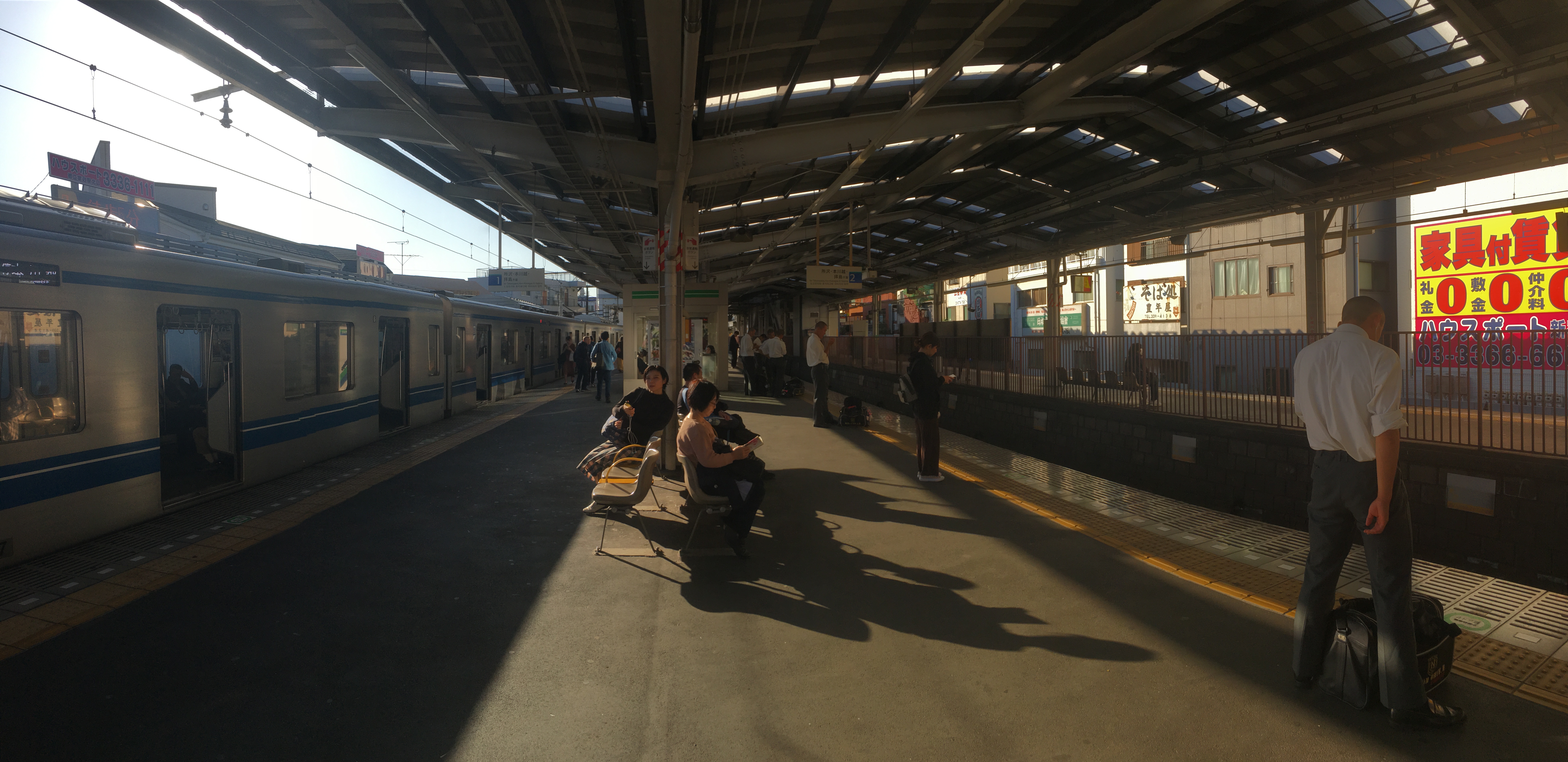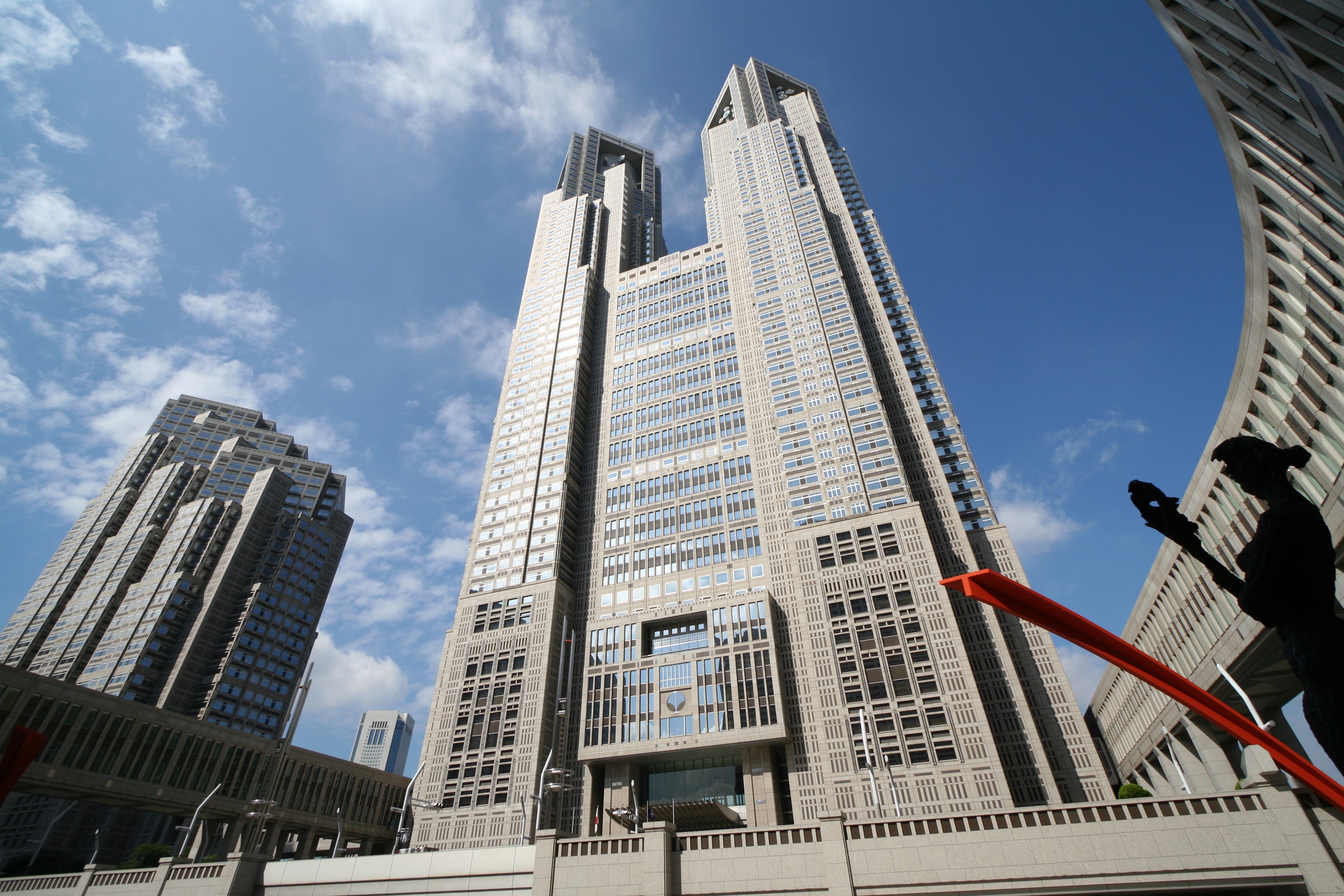|
Saginomiya Station (Tokyo)
is a railway station in Nakano, Tokyo, Japan. It is served by trains running on the private Seibu Railway's Seibu Shinjuku Line between (8.5 km away) in Tokyo and (39 km away) in Saitama Prefecture is a landlocked prefecture of Japan located in the Kantō region of Honshu. Saitama Prefecture has a population of 7,338,536 (1 January 2020) and has a geographic area of 3,797 km2 (1,466 sq mi). Saitama Prefecture borders Tochigi Prefecture .... History Saginomiya Station opened on 16 April 1927. Station numbering was introduced on all Seibu Railway lines during fiscal 2012, with Saginomiya Station becoming "SS09". Passenger statistics In fiscal 2016, the station was the 31st busiest on the Seibu network with an average of 31,671 passengers daily. The passenger figures for previous years are as shown below. References External links Saginomiya station information {{Coord, 35.7225, N, 139.6389, E, type:railwaystation_region:JP, display=title Railway st ... [...More Info...] [...Related Items...] OR: [Wikipedia] [Google] [Baidu] |
Nakano, Tokyo
is a special ward in Tokyo, Japan. The English translation of its Japanese self-designation is Nakano City.About Nakano City " Retrieved March 10, 2013. As of May 1, 2015, the ward has an estimated population of 322,731, and a population density of 20,701 persons per km2. The total area is 15.59 km2. Nakano is the most densely populated city in Japan. History The ward was founded on October 1, 1932, when the towns of Nogata and Nakano were absorbed into the former as Nakano Ward. The present administration dates from March 15, 1947, when the Allied occupation reformed the administration of Tokyo-to ...[...More Info...] [...Related Items...] OR: [Wikipedia] [Google] [Baidu] |
Tokyo, Tokyo
Tokyo (; ja, 東京, , ), officially the Tokyo Metropolis ( ja, 東京都, label=none, ), is the capital and largest city of Japan. Formerly known as Edo, its metropolitan area () is the most populous in the world, with an estimated 37.468 million residents ; the city proper has a population of 13.99 million people. Located at the head of Tokyo Bay, the prefecture forms part of the Kantō region on the central coast of Honshu, Japan's largest island. Tokyo serves as Japan's economic center and is the seat of both the Japanese government and the Emperor of Japan. Originally a fishing village named Edo, the city became politically prominent in 1603, when it became the seat of the Tokugawa shogunate. By the mid-18th century, Edo was one of the most populous cities in the world with a population of over one million people. Following the Meiji Restoration of 1868, the imperial capital in Kyoto was moved to Edo, which was renamed "Tokyo" (). Tokyo was devastated ... [...More Info...] [...Related Items...] OR: [Wikipedia] [Google] [Baidu] |
Tokyo
Tokyo (; ja, 東京, , ), officially the Tokyo Metropolis ( ja, 東京都, label=none, ), is the capital and largest city of Japan. Formerly known as Edo, its metropolitan area () is the most populous in the world, with an estimated 37.468 million residents ; the city proper has a population of 13.99 million people. Located at the head of Tokyo Bay, the prefecture forms part of the Kantō region on the central coast of Honshu, Japan's largest island. Tokyo serves as Japan's economic center and is the seat of both the Japanese government and the Emperor of Japan. Originally a fishing village named Edo, the city became politically prominent in 1603, when it became the seat of the Tokugawa shogunate. By the mid-18th century, Edo was one of the most populous cities in the world with a population of over one million people. Following the Meiji Restoration of 1868, the imperial capital in Kyoto was moved to Edo, which was renamed "Tokyo" (). Tokyo was devastate ... [...More Info...] [...Related Items...] OR: [Wikipedia] [Google] [Baidu] |
Seibu Railway
is a conglomerate based in Tokorozawa, Saitama, Japan, with principal business areas in railways, tourism, and real estate. Seibu Railway's operations are concentrated in northwest Tokyo and Saitama Prefecture; the name "Seibu" is an abbreviation of "west Musashi", referring to the historic name for this area. It and its holding company hold shares of numerous bus, hotel and tourism operations nationwide. History "Seibu Railway" was originally the name of a tram service between Shinjuku and Ogikubo, which was transferred to the Tokyo metropolitan government in 1951 and eventually closed in 1962. The Seibu Railway was acquired in 1921 by the Kawagoe Railway, which had operated a train service between Kokubunji and Kawagoe since 1894; the merged company kept the "Seibu" name and expanded its main line to Takadanobaba, forming what is now known as the Seibu Shinjuku Line. The current Seibu Railway is a product of a 1945 merger between the former Seibu Railway and the Musashino ... [...More Info...] [...Related Items...] OR: [Wikipedia] [Google] [Baidu] |
Seibu Shinjuku Line
The is a Japanese railway line owned by the private railway operator Seibu Railway, connecting Seibu Shinjuku Station in Shinjuku, Tokyo with Hon-Kawagoe Station in Kawagoe, Saitama. The Shinjuku Line is one of two main lines of the Seibu Railway system along with the Ikebukuro Line. The two main lines cross at Tokorozawa Station in Tokorozawa, Saitama. The line serves the western suburbs of Tokyo, connecting them to Shinjuku and other areas of downtown Tokyo. Description The line is mostly double-track, except for 1.1 km (1200 yards) of single track between Wakita Junction and Hon-Kawagoe Station. While the section from Seibu-Shinjuku to Takadanobaba is elevated, the line runs at ground level through a suburban area until Saginomiya. Trains Seven types of train service are operated on the line: Local, Semi Express, Express, Commuter Express, Rapid Express, Haijima Liner, and ''Koedo'' limited express, as shown below. Limited Express trains use Seibu 10000 series EMUs, ... [...More Info...] [...Related Items...] OR: [Wikipedia] [Google] [Baidu] |
Saitama Prefecture
is a landlocked prefecture of Japan located in the Kantō region of Honshu. Saitama Prefecture has a population of 7,338,536 (1 January 2020) and has a geographic area of 3,797 km2 (1,466 sq mi). Saitama Prefecture borders Tochigi Prefecture and Gunma Prefecture to the north, Nagano Prefecture to the west, Yamanashi Prefecture to the southwest, Tokyo to the south, Chiba Prefecture to the southeast, and Ibaraki Prefecture to the northeast. Saitama is the capital and largest city of Saitama Prefecture, with other major cities including Kawaguchi, Kawagoe, and Tokorozawa. Saitama Prefecture is part of the Greater Tokyo Area, the most populous metropolitan area in the world, and many of its cities are described as bedroom communities and suburbs of Tokyo with many residents commuting into the city each day. History According to ''Sendai Kuji Hongi'' (''Kujiki''), Chichibu was one of 137 provinces during the reign of Emperor Sujin. Chichibu Province was in western Saitama. ... [...More Info...] [...Related Items...] OR: [Wikipedia] [Google] [Baidu] |
Railway Stations In Tokyo
Rail transport (also known as train transport) is a means of transport that transfers passengers and goods on wheeled vehicles running on rails, which are incorporated in tracks. In contrast to road transport, where the vehicles run on a prepared flat surface, rail vehicles ( rolling stock) are directionally guided by the tracks on which they run. Tracks usually consist of steel rails, installed on sleepers (ties) set in ballast, on which the rolling stock, usually fitted with metal wheels, moves. Other variations are also possible, such as "slab track", in which the rails are fastened to a concrete foundation resting on a prepared subsurface. Rolling stock in a rail transport system generally encounters lower frictional resistance than rubber-tyred road vehicles, so passenger and freight cars (carriages and wagons) can be coupled into longer trains. The operation is carried out by a railway company, providing transport between train stations or freight customer fac ... [...More Info...] [...Related Items...] OR: [Wikipedia] [Google] [Baidu] |



